Buying a first car
Young drivers tend to drive small cars, and until fairly recently, all of the best safety tech was reserved for medium or large models. But not any more, and below we’ve run through some of the key safety technologies now available on many new small cars. Buy an older supermini or city car and the chances are it won’t feature much of the life-saving tech below.
Clearly, if they’re able to drive a newer car your child will be much better protected in the event of a collision – and they’re also less likely to be involved in a collision in the first place. While new cars are more costly to buy than older models, they're often significantly cheaper to run thanks to more efficient engines and having covered fewer miles. The question is: can you afford to help your child buy a newer car? Or more to the point, can you afford not to?
Watch a short video on buying a first car
Must-have safety features
Modern cars come with a huge array of safety features, both active and passive. The active (or primary) systems help to prevent a crash, while passive (or secondary) systems aim to reduce injuries in the event of a collision. Think of the list below as a "wish-list" for your child's first car.
ACTIVE EQUIPMENT
- Electronic Stability Programe (ESP)
Sometimes called Electronic Stability Control (ESC), this helps drivers avoid crashes by reducing the danger of skidding, or losing control as a result of swerving at speed or going into a corner too quickly. ESP ties together the sensors for a car’s traction control and anti-lock braking systems; it’s been mandatory on all new cars sold since 31 October 2014. But the technology has been around since 1995 which is why many cars from the past decade have it fitted. Confusingly, many car makers have their own name for ESP, such as VSC (Vehicle Stability Control), DSC (Dynamic Stability Control) and VSA (Vehicle Stability Assist).
- Auto Emergency Braking (AEB)
This tech hasn’t been around for long but already it’s available on some of the smallest cars around. Generally not fitted as standard, the thinking is that making this mandatory on all new cars is the last easy way of significantly cutting injuries. The system works by firing a radar beam from the front of the car and if it detects something ahead the brakes are automatically applied if there’s no sign of the driver reacting to the impending hazard.
- Traction control
When the going gets slippery it’s easy to spin away the engine’s power, or potentially to skid off the road. Traction control optimises a car’s grip and stability when accelerating. Wheelspin is reduced (or even eliminated) by reducing engine power or temporarily applying the brakes to that wheel, allowing the car to accelerate smoothly.
- Active braking
Active braking systems provide braking support during emergency situations. There are many versions of active braking systems. Preliminary systems assist drivers by warning them of impending collisions. More advanced systems automatically assist drivers in preventing collisions.
- Visibility
It’s amazing how rubbish old cars are in terms of visibility. Poor headlights and sub-standard demisting systems were the norm, but it’s no longer like that. Nowadays many cars are available with a heated windscreen, better lighting and daytime running lights. The latter are now compulsory on new cars to ensure you’re seen more easily. A lot of modern cars also feature air conditioning which isn’t just for keeping cool in the summer – in the winter, in combination with the heater, it helps to stop the windows misting up.
- Road sign recognition
Speed limits change constantly and it can be hard keeping up. So help you stay within the limit some car makers now fit cameras that recognise road signs then display them on the dashboard. These might include warning signs but at the very least it’ll include speed limit signs so you know if you’re breaking the limit.
- Tyre pressure monitoring
Drivers are rubbish at checking their tyre pressures, which is why all cars sold from 1 November 2014 must have a tyre pressure monitoring system fitted. There are different systems available but at the very least your car’s dashboard should illuminate if one of your tyres goes soft. All we need next is something to warn of insufficient tread – although believe it or not, car makers are working on it...
PASSIVE EQUIPMENT
- Crumple zones
Modern cars protect drivers and passengers in frontal, rear and offset crashes by using crumple zones to absorb crash energy. This means that the car absorbs the impact of the crash, not the driver or passengers. At the same time, the cabin remains intact, so the steering wheel, pedals, dashboard and interior fittings are designed to minimise injuries.
- Side impact protection
Increased side door strength, internal padding and better seats can improve protection in side impact crashes. Most new cars have side intrusion beams or other protection within the door structure. Some cars also have padding on the inside door panels. Increasingly, car manufacturers are installing side airbags that provide protection from severe injury. Head-protecting side airbags, such as curtain airbags, are highly effective in side impact and rollover crashes.
- Seatbelts
A properly worn seat belt provides good protection but doesn’t always prevent injuries. To increase effectiveness, seatbelt pre-tensioners have become more common in recent years. These stop the seatbelt reeling out before tightening in an impact, while load limiters manage the forces applied to the body in a crash. Modern cars also come with seat belt warning systems to remind you if seatbelts haven’t been fastened.
- Airbags
Airbags have been around in the US since the early 1970s, but didn’t become common in the UK until the last 1990s. In a crash an airbag inflates very quickly to cushion the impact, then deflates again – also very quickly. Crucially, an airbag is designed to supplement the protection provided by seatbelts; they’re not a substitute. The best protection in frontal crashes is achieved using a properly worn seat belt in combination with an airbag.
- Head restraints
Head restraints should be fitted to all seats, front and back as their positioning is critical for preventing whiplash in rear impact crashes. Whiplash is caused by the head extending backward from the torso in the initial stage of rear impact, then being thrown forward. To prevent whiplash the head restraint should be at least as high as the head's centre of gravity (eye level and higher) and as close to the back of the head as possible.
AND THERE’S MORE...
Buy a more expensive modern car and it’ll come with a whole raft of high-tech equipment that’ll help prevent a crash or offer better protection in the event of one. Such pieces of equipment include fatigue detection, lane departure warning, blind spot warning systems, active cruise control and maybe even a head-up display. With the move towards self-driving cars, even these pieces of technology are relatively basic compared with what’s on the way!
EURO NCAP CRASH TESTS
We all hear about a car’s Euro NCAP rating, but what does the term actually mean? In simple terms, a Euro NCAP rating gives an indication of how safe a car is, the name coming from the European New Car Assessment Programme.
This independent body takes new cars and slams them into various walls and blocks, to see how they withstand impacts. But it’s not just about a car’s strength; Euro NCAP also looks at what kit is fitted as standard, such as ESP (Electronic Stability Programme), seatbelt reminders and speed limiters.
Until 2009, all cars were awarded a star rating according to how well they looked after adult or child occupants, as well as how little damage they did to pedestrians. But the system has now changed so that just one rating is given to the car - which means that to get a five-star award, the car has to be fitted with lots of safety features, be very strong so it looks after its occupants both large and small and it also can't mangle pedestrians too much.
It’s this last one that’s the trickiest, as when a car hits a pedestrian, the car is pretty much guaranteed to win every time. To get the Euro NCAP safety rating for any car you’re thinking of buying, log on to www.euroncap.com







